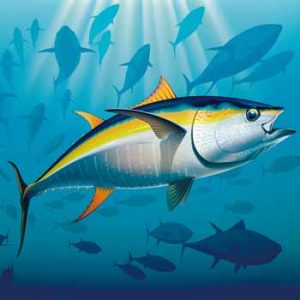
More evidence that low-calorie sweeteners are bad for your health
Studies show that artificial sweeteners can raise the risk of hypertension, metabolic syndrome, type 2 diabetes and heart disease, including stroke.

Most of us consider fish a healthy eating choice.
Fish, especially oily fish is high in protein, low in saturated fats and high in essential omega-3s that are anti-inflammatory and can help protect us against things like depression, pancreatic cancer, and even hearing loss.
But there is a problem. Our oceans are increasingly polluted with persistent organic pollutants (POPs), toxic substances like DDT and mercury, as well as newer industrial chemicals, such as flame retardants and coolants that don’t easily break down in nature.
A recent study has highlighted how important it is to make better fish choices if we want to get the best form fish.
A recent study, published in the journal Science Advances, showed that environmental pollutants found in fish can disable the human body’s natural defence system which helps it expel harmful toxins.
Breaking the body’s defences
According to the research team, led by scientists from Scripps Institution of Oceanography at University of California, San Diego, a protein called P-gp, or P-glycoprotein, found in cells of nearly all plants and animals, acts like the cell’s ‘bouncer’ by expelling foreign chemicals from the body.
» Seafood can provide a high protein, low saturated fat, high omega-3 boost to our diets.
» But our fish swim in increasingly polluted oceans and the flesh of larger species can be especially polluted with persistent organic pollutants (POPs).
» Recent evidence shows that POPs found in fish, such as the flame retardant PBDE-100, disrupt the body’s ability to detoxify itself.
P-gp is well known for its ability to transport therapeutic drugs out of cancer cells and, in some cases, rendering these cells resistant to multiple drugs at once.
To determine how effective P-gp is at ridding cells of POPs found in seafood, the team looked at how effective P-gp proteins from humans and mice were against POPs. The scientists focused on the 10 POPs most commonly found in human blood and urine, as well as in the flesh of wild-caught yellowfin tuna.
All 10 pollutants interfered with the ability of P-gp to protect cells. In addition, the study was the first to show that one POP, the flame retardant known as PBDE-100, bound to the protein and rendered it unable to protect cells against foreign chemicals.
“When we eat contaminated fish, we could be reducing the effectiveness of this critical defence system in our bodies,” said Amro Hamdoun, an associate professor in the Marine Biology Research Division at Scripps, and lead author of the study.
Unique vulnerabilities
The researchers point out that newborns and fish larvae are two of the most vulnerable populations. Newborns are particularly vulnerable since they are exposed to high concentrations of POPs in breast milk, and have low amounts of the protective P-gp protein.
Fish larvae may be at increased risk since the accumulation of pollutants may slow down the animal’s defence system to combat other marine pollutants, such as oil hydrocarbons encountered at oil spill sites.
The results, say the researchers, suggest that environmental chemicals must be tested to determine if they impede the effectiveness of the body’s natural defence system. The US Food and Drug Administration currently recommends similar testing on drugs.
It is likely that top ocean predators like tuna carry more than one toxin and this too is worrying since a synergistic effect of these toxins could make them even more damaging to the body’s defence systems.
So what can we eat?
The results of the study show how careful we need to be when choosing ‘healthy fish’. The problem is there is still not comprehensive guide to the safest fish to eat on a global scale.
California’s Monterey Bay Aquarium’s produces a ‘Super Green’ list of seafood which may provide some useful guidance – at least in the States.
The list includes fish that are farmed or wild caught in US waters and draws a wide range of data on POPs and human health, notably scientists from the Harvard School of Public Health (HSPH) and Environmental Defense Fund (EDF) and includes fish that come from the least-pressured habitats, and so are more likely to be free of industrial pollutants like mercury and dioxins, and also contain the highest levels of healthy omega-3 fatty acids.
The ‘best of the best’ include:
Other good choices include:
No similar publication exists in the EU or in countries like Australia. The Marine Stewardships council does provide information on sustainable fish, which may provide a starting point. As a general rule large predators like shark, larger tuna species and swordfish are most likely to accumulate the most POPs and best avoided.
The website Greenopedia has some good advice on how to balance sustainability, the potential pitfalls of farmed fish and pollution. The general lack of international information places a difficult burden on consumers to ‘cross reference’ what is known about sustainability with what is known about the most polluted fish species. This information void, of course, works in the favour of those who keep polluting the oceans, since it makes it harder for consumers to make clear choices for themselves and their families.

Please subscribe me to your newsletter mailing list. I have read the
privacy statement